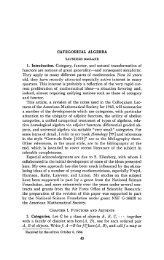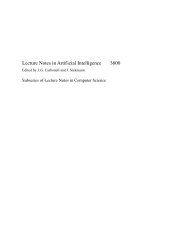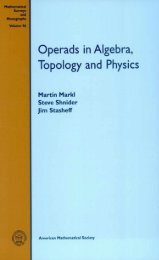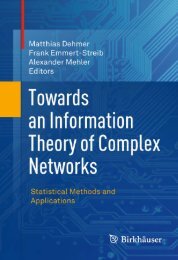Symmetric Monoidal Categories for Operads - Index of
Symmetric Monoidal Categories for Operads - Index of
Symmetric Monoidal Categories for Operads - Index of
Create successful ePaper yourself
Turn your PDF publications into a flip-book with our unique Google optimized e-Paper software.
206 13 The (Co)homology <strong>of</strong> Algebras over <strong>Operads</strong><br />
this resolution with the usual Hochschild (respectively, Chevalley-Eilenberg,<br />
Harrison) complex.<br />
The Hochschild cohomology and the Chevalley-Eilenberg cohomology (respectively,<br />
homology) can also be defined by an Ext-functor (respectively, a<br />
Tor-functor). This result has an interpretation in terms <strong>of</strong> a general universal<br />
coefficient spectral sequence, defined in the next section, which relates any<br />
cohomology (respectively, homology) associated to an operad to Ext-functors<br />
(respectively, Tor-functors).<br />
13.1.6 ¶ Remark. If we use simplicial k-modules rather than dg-modules,<br />
then the definition <strong>of</strong> the cohomology H ∗ P<br />
(A, E), respectively homology<br />
H P ∗(A, E), makes sense <strong>for</strong> any simplicial operad P which is c<strong>of</strong>ibrant in<br />
simplicial k-modules, and not only <strong>for</strong> Σ∗-c<strong>of</strong>ibrant operads. In particular,<br />
we can use P-algebras in simplicial k-modules to associate a well-defined<br />
(co)homology theory to the Lie, respectively commutative, operad in positive<br />
characteristic. In the case <strong>of</strong> the Lie operad, this simplicial (co)homology<br />
agrees again with the Chevalley-Eilenberg (co)homology. In the case <strong>of</strong> the<br />
commutative operad, this simplicial (co)homology agrees with André-Quillen’<br />
(co)homology.<br />
13.1.7 Universal Coefficients. The remainder <strong>of</strong> the section is devoted<br />
to the pro<strong>of</strong> <strong>of</strong> proposition 13.1.2 and proposition 13.1.4, the homotopy invariance<br />
<strong>of</strong> the dg-modules DerP(QA,E)andE ⊗ UP(QA) Ω 1 P (QA), <strong>for</strong> QA a<br />
c<strong>of</strong>ibrant replacement <strong>of</strong> A.<br />
For this aim, we use the representation<br />
T 1 P (QA) =UP(A) ⊗ UP(QA) Ω 1 P (QA)<br />
which determines the homology <strong>of</strong> A with coefficients in the enveloping algebra<br />
UP(A). The enveloping algebra UP(A) gives universal coefficients <strong>for</strong> the<br />
homology <strong>of</strong> A since we have identities<br />
DerP(QA,E)=HomUP(QA)Mod(Ω 1 P (QA),E)<br />
= HomUP(A)Mod(T 1 P (QA),E)<br />
and E ⊗UP(QA) Ω 1 P (QA) =E ⊗UP(A) T 1 P (QA).<br />
The idea is to prove that the functor QA ↦→ T 1 P (QA) maps c<strong>of</strong>ibrant<br />
P-algebras over A to c<strong>of</strong>ibrant left UP(A)-modules and preserves weakequivalences<br />
between c<strong>of</strong>ibrant P-algebras. Then we apply the classical<br />
homotopy theory <strong>of</strong> modules over dg-algebras to conclude that the functors<br />
QA ↦→ Hom UP(A)Mod(T 1 P (QA),E) and QA ↦→ E ⊗ UP(A) T 1 P (QA) preserve<br />
weak-equivalences between c<strong>of</strong>ibrant P-algebras over A.<br />
In our verifications, we use repeatedly that the extension and restriction<br />
functors<br />
φ! : R Mod ⇄ S Mod : φ ∗






